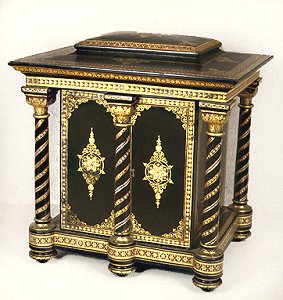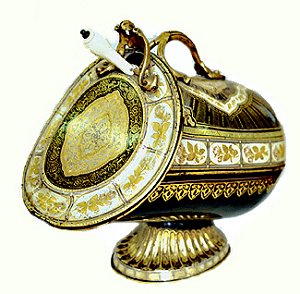|
Introduction
From the dirt and smoke of Bilston came pretty little
decorated enamels. From the dirt and smoke of Wolverhampton came
spectacular and glamorous japanned ware.
 |
Cabinet containing six drawers, in the "moresque"
style, by F. Walton and Co., Wolverhampton, about 1850. Photo c.Wolverhampton City Council 2001.
|
An excellent idea of the range and
splendour of japanned ware can be gained from visiting Bantock House,
where many items from of one of the largest collections in the country
are well displayed.
For the purposes of this virtual museum, we have divided
our display into three parts:
|

|
|

|
|

|
|
Japanning -
what it is and
how
it developed |
|
Japanning -
manufacturing methods & organisation of the trade |
|
Japanning -
the
leading makers |
| A remarkable coal scuttle, known as the Ruskin
Persian Scoop, japanned on tin, with a black ground decorated with gold
leaf and colours. Marked "H.L.&Co Ruskin", for Henry Loveridge &
Co.. This example is probably the one exhibited by Loveridge's at
the Wolverhampton Exhibition of Art and Manufacture, 1869.
Photo
copyright Wolverhampton City Council 2001. |
 |
The information on these pages has been mainly got
from:
Yvonne Jones, Georgian and Victorian Japanned Wares
of the West Midlands, Wolverhampton Art Gallery and Museums, 1982
Shirley Spalding Dove, English Papier Mache of the Georgian and
Victorian Periods, Barrie and Jenkins, London, 1971
Jane Toller, Papier Mache in Great Britain and America, G. Bell and
Sons, London, 1962
The illustrations on this and the other japanning
pages have been kindly provided by the Wolverhampton City Council.
All the illustrations are copyright and may not be reproduced without
the express consent of the copyright owners. We would like to thank
Philippa Tinsley, Helen Statham and Susannah Gilbert for their help with
photos and captions - but they are, of course, not responsible for our
results.
|

